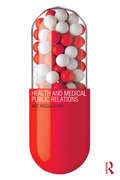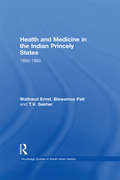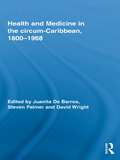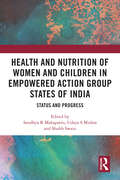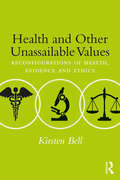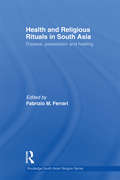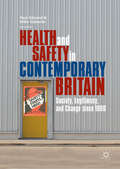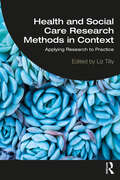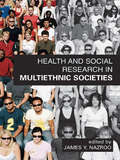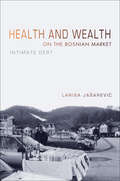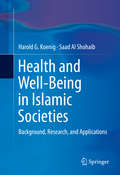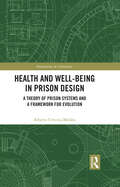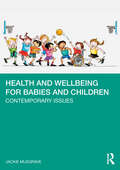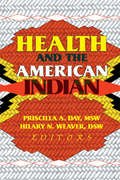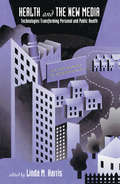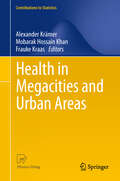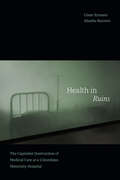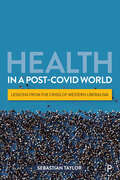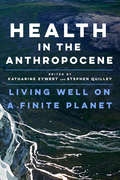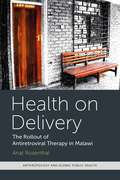- Table View
- List View
Health and Inequality: Applying Public Health Research to Policy and Practice
by Angela M. Tod Julia HirstHow can research on the social determinants of health be translated into real life public health practice? Challenging the research-practice gap, this text shows readers from a range of professions how their practice can help to minimise health inequalities. The social model of health embraces individual lifestyles, social and community networks, socio-economic, political and cultural influences and the plethora of factors that can impact on public health, for instance, education, work, welfare benefits, environment, housing, health and social care. All of these can have a significant effect on people’s experiences of health and well-being, and are often unrecognised sources of health inequalities. This innovative textbook outlines and discusses key public health principles and the social model of health. Drawing on a range of case studies and the international literature, it looks at how public health research has been applied to policy and practice. The book discusses the transferability that these findings have had and their capacity to influence and provide evidence for practice. Health and Inequality covers a broad range of social determinants of health, encountered throughout the life-course, including: Pre-birth and early years Breastfeeding and teenage mothers Health inequalities for mothers and babies in prison Children in full time education Sexuality, relationships and sexual health of young people Early adulthood Welfare rights and health benefits Women, employment and well-being Adults in later life Practical and clearly structured, this text will be useful to a range of health and social care professionals involved in public health work, particularly those undertaking courses on public health, health promotion or the social determinants of health.
Health and Medical Geography, Fourth Edition
by Elisabeth Dowling Root Margaret Carrel Michael EmchWhy are rainfall, carcinogens, and primary care physicians distributed unevenly over space? The fourth edition of the leading text in the field has been updated and reorganized to cover the latest developments in disease ecology and health promotion across the globe. The book accessibly introduces the core questions and perspectives of health and medical geography and presents cutting-edge techniques of mapping and spatial analysis. It explores the intersecting genetic, ecological, behavioral, cultural, and socioeconomic processes that underlie patterns of health and disease in particular places, including how new diseases and epidemics emerge. Geographic dimensions of health care access and service provision are addressed. More than 100 figures include 16 color plates; most are available as PowerPoint slides at the companion website. New to This Edition: *Chapters on the political ecology of health; emerging infectious diseases and landscape genetics; food, diet, and nutrition; and urban health. *Coverage of Middle East respiratory syndrome, Ebola, and Zika; impacts on health of global climate change; contaminated water crises in economically developed countries, including in Flint, Michigan; China's rapid industrial growth; and other timely topics. *Updated throughout with current data and concepts plus advances in GIS. *A range of pedagogical features. Pedagogical Features: *End-of-chapter review questions and suggestions for further reading. *Section Introductions that describe each chapter. *"Quick Reviews"--within-chapter recaps of key concepts. *Bold-faced key terms and an end-of-book glossary.
Health and Medical Public Relations
by Myc RiggulsfordHealth and Medical Public Relations takes a fresh look at media relations and news values. It examines how information about medical research from the academic, pharmaceutical and charitable sectors is disseminated to target audiences through a variety of PR techniques. Scrutinising a wide range of health-related public relations activities, the book combines a critical, analytical and cultural overview of these methods with helpful guidance on their practical application. Key features include: Advice on how to write and place effective press releases, plan and budget for campaigns, and anticipate responses from different sectors and the wider public Coverage of different types of communication and consultancy, including the controversial areas of lobbying and access to influential policy makers Case studies on the way in which experienced journalists and public relations practitioners gain coverage for their work, with plentiful examples drawn from both recent media scares and long-running issues A survey of the way challenging public relations issues have been perceived in the past, analysing the attitudes of both legislators and the public A user-friendly format designed to reinforce learning, including handy tips, definition boxes explaining key words and concepts, and exercises and reflection points to stimulate group discussion and reflection on specific examples of science and medical PR practice. Wide-ranging and highly accessible, this book will be an essential resource for undergraduates, postgraduates and professionals learning to specialise in health public relations.
Health and Medicine in the Indian Princely States: 1850-1950 (Routledge Studies in South Asian History)
by Waltraud Ernst Biswamoy Pati T.V. SekherSince the 1980s there has been a continual engagement with the history and the place of western medicine in colonial settings and non-western societies. In relation to South Asia, research on the role of medicine has focussed primarily on regions under direct British administration. This book looks at the ‘princely states’ that made up about two fifths of the subcontinent. Two comparatively large states, Mysore and Travancore – usually considered as ‘progressive’ and ‘enlightened’ – and some of the princely states of Orissa – often described as ‘backward’ and ‘despotic’ – have been selected for analysis. The authors map developments in public health and psychiatry, the emergence of specialised medical institutions, the influence of western medicine on indigenous medical communities and their patients and the interaction between them. Exploring contentious issues currently debated in the existing scholarship on medicine in British India and other colonies, this book covers the ‘indigenisation’ of health services; the inter-relationship of colonial and indigenous paradigms of medical practice; the impact of specific political and administrative events and changes on health policies. The book also analyses British medical policies and the Indian reactions and initiatives they evoked in different Indian states. It offers new insights into the interplay of local adaptations with global exchanges between different national schools of thought in the formation of what is often vaguely, and all too simply, referred to as 'western' or 'colonial' medicine. A pioneering study of health and medicine in the princely states of India, it provides a balanced appraisal of the role of medicine during the colonial era. It will be of interest to students and academics studying South Asian and imperial and commonwealth history; the history of medicine; the sociology of health and healing; and medical anthropology, social policy, public health, and international politics.
Health and Medicine in the circum-Caribbean, 1800-1968 (Routledge Studies in the Social History of Medicine #Vol. 33)
by Steven Palmer David Wright Juanita De BarrosHealth and medicine in colonial environments is one of the newest areas in the history of medicine, but one in which the Caribbean is conspicuously absent. Yet the complex and fascinating history of the Caribbean, borne of the ways European colonialism combined with slavery, indentureship, migrant labour and plantation agriculture, led to the emergence of new social and cultural forms which are especially evident the area of health and medicine. The history of medical care in the Caribbean is also a history of the transfer of cultural practices from Africa and Asia, the process of creolization in the African and Asian diasporas, the perseverance of indigenous and popular medicine, and the emergence of distinct forms of western medical professionalism, science, and practice. This collection, which covers the French, Hispanic, Dutch, and British Caribbean, explores the cultural and social domains of medical experience and considers the dynamics and tensions of power. The chapters emphasize contestations over forms of medicalization and the controls of public health and address the politics of professionalization, not simply as an expression of colonial power but also of the power of a local elite against colonial or neo-colonial control. They pay particular attention to the significance of race and gender, focusing on such topics as conflicts over medical professionalization, control of women’s bodies and childbirth, and competition between ‘European’ and ‘Indigenous’ healers and healing practices. Employing a broad range of subjects and methodological approaches, this collection constitutes the first edited volume on the history of health and medicine in the circum-Caribbean region and is therefore required reading for anyone interested in the history of colonial and post-colonial medicine.
Health and Nutrition of Women and Children in Empowered Action Group States of India: Status and Progress
by Sandhya R Mahapatro, Udaya S Mishra and Shubh SwainThis book tracks the progress of maternal and child health (MCH)—part of SDG3—in empowered action group states in India. It lays bare regional disparities and unfolds a range of issues relating to inequalities in access to MCH services, complex dynamics behind poor nutrition, health expenditure and impoverishment, structural bottlenecks of health system that hinder effective implementation of programmes; best practices adopted for improving MNCH indicators and appropriate strategies required for more informed policy. The volume: Examines the changing features of health and nutrition of mothers, new-borns and children between pre and post National Rural Health Mission (NRHM) Studies reproductive health and well-being of mother and children Explores linkages between food, nutrition and health Examines the underlying factors determining poor health and nutrition Probes into health expenditure, their impoverishment and its bearing on access to maternal and child healthcare services Proposes strategic interventions to reduce maternal, neonatal and child mortality and improve nutritional status The volume will be of great interest to scholars and researchers of public health, especially maternal and child health specialists, gender studies, development studies and public policy.
Health and Other Unassailable Values: Reconfigurations of Health, Evidence and Ethics
by Kirsten BellHealth and Other Unassailable Values sets out to examine health as a core cultural value. Taking ‘health’, ‘evidence’ and ‘ethics’ as her primary themes, Bell explores the edifice that underpins contemporary conceptions of health and the transformations in how we understand it, assess it and enact it. Although health, evidence and ethics have always been important values, she demonstrates that the grounds upon which they are grasped today are radically different from how they were formulated in the past. Divided into three parts, Part I focuses on the rise of epidemiology, Part II examines the emergence of evidence-based medicine, and Part III explores the broader ethical turn in health and medicine. Through an examination of core concepts including health behaviour, the randomised controlled trial, informed consent and human rights, Bell illustrates the ways in which certain entrenched ideas and assumptions about how human beings think and act recur across a variety of settings. An array of topical case studies, including cigarette packaging legislation, the incorporation of male circumcision as an HIV prevention tool, cancer screening technologies and e-cigarettes, ground the arguments presented. Written in a clear and engaging style, this volume will be of interest to a wide range of scholars and students, especially those in medical anthropology, medical sociology and public health. Clear chapter delineations make the work easy to engage with at the individual chapter level as well as a whole.
Health and Religious Rituals in South Asia: Disease, Possession and Healing (Routledge South Asian Religion Series)
by Fabrizio M. FerrariDrawing on original fieldwork, this book develops a fresh methodological approach to the study of indigenous understandings of disease as possession, and looks at healing rituals in different South Asian cultural contexts. Contributors discuss the meaning of 'disease', 'possession' and 'healing' in relation to South Asian religions, including Hinduism, Islam, Buddhism and Sikhism, and how South Asians deal with the divine in order to negotiate health and wellbeing. The book goes on to look at goddesses, gods and spirits as a cause and remedy of a variety of diseases, a study that has proved significant to the ethics and politics of responding to health issues. It contributes to a consolidation and promotion of indigenous ways as a method of understanding physical and mental imbalances through diverse conceptions of the divine. Chapters offer a fascinating overview of healing rituals in South Asia and provide a full-length, sustained discussion of the interface between religion, ritual, and folklore. The book presents a fresh insight into studies of Asian Religion and the History of Medicine.
Health and Safety for Learning Disability Workers
by Alice BradleyIf you are working within the learning disability sector and studying for the QCF Diploma in Health and Social Care, you will find this book an invaluable resource in helping you to achieve the units on Health and Safety. You will find the book easy to navigate, with each chapter covering one of the learning outcomes within the unit. Each chapter begins with an example taken from real people's stories and lots of activities, photographs and other illustrations are included throughout the book so you can really get to grips with the subject.
Health and Safety in Contemporary Britain: Society, Legitimacy, And Change Since 1960
by Mike Esbester Paul AlmondThis book analyses the perceived legitimacy of health and safety in post-1960 British public life. Since 2010 health and safety has appeared to be in crisis, being attacked by press, politicians and public alike, but are these claims of crisis accurate? How have understandings of health and safety changed over the past 60 years? By exploring the history, culture, and operation of health and safety in contemporary Britain, this book provides a new assessment of an understudied, but surprisingly far-reaching, part of the British political and social landscape. Combining archival research with focus group, social survey and oral history testimony, the book examines the historical background to health and safety, how health and safety has been enacted in public and in the workplace, the impact of changing economic, occupational and social structures on the operation of health and safety, and the conflicts and interests that have shaped the area.
Health and Safety: A Breakdown
by Emily Witt&“Haunting . . . [Witt] writes with such cool precision.&”—Jennifer Szalai, New York Times "Witt elevates writing about altered states of consciousness to something akin to the most brilliant art criticism I&’ve ever read."—Jia Tolentino, bestselling author of Trick Mirror From the New Yorker staff writer and acclaimed author of Future Sex, a memoir about drugs, techno, and New York CityIn the summer of 2016, a divisive presidential election was underway, and a new breed of right-wing rage was on the rise. Emily Witt, who would soon publish her first book on sex in the digital age, had recently quit antidepressants for a more expansive world of psychedelic experimentation. From her apartment in Brooklyn, she began to catch glimpses of the clandestine nightlife scene thrumming around her.In Health and Safety, Witt charts her immersion into New York City&’s dance music underground. Emily would come to lead a double life. By day she worked as a journalist, covering gun violence, climate catastrophes, and the rallies of right-wing militias. And by night she pushed the limits of consciousness in hollowed-out office spaces and warehouses to music that sounded like the future. But no counterculture, no matter how utopian, could stave off the squalor of American politics and the cataclysm of 2020.Affectionate yet never sentimental, Health and Safety is a lament for a broken relationship, for a changed nightlife scene, and for New York City just before the fall. Sparing no one—least of all herself—Witt offers her life as a lens onto an era of American delirium and dissolution.
Health and Social Care Research Methods in Context: Applying Research to Practice
by Liz TillyThis is the first textbook to show how research using a range of qualitative and quantitative methods relates to improving health and social care practice. The book shows how different research approaches are undertaken in practice and the challenges and strengths of different methodologies, thus facilitating students to make informed decisions when choosing which to use in their own research projects. The eleven chapters are each structured around different research methods and include: A brief overview of the research and research question Identification and overview of the research approach and associated methods selected to answer this question The sample and recruitment, including issues and challenges Ethical concerns Practical issues in undertaking the research approach Links between the research process and findings to health and social care values Links to the full research study Further reading The book will be a required reading for all students of social work; social care; nursing; public health and health studies and particularly suitable for those on widening participation courses.
Health and Social Research in Multiethnic Societies
by James Y. NazrooThis volume presents a ready source of information on the methodological issues facing research on ethnicity, which is highly relevant to a wide variety of health, economic and social issues in modern societies. Straightforward in its approach and accessible to those who are not specialists in studies of ethnicity, Health and Social Research in Multiethnic Societies provides essential and clear guidance on appropriate methods. Topics covered include: approaches to conceptualizing ethnicity and understanding the context of ethnicity in modern societies ethical issues and the political context within which ethnicity research is conducted engagement with researched communities, and with users more broadly cultural competence in research practical issues faced by both qualitative and quantitative research use of secondary and administrative data sources for research. Using a combination of critical analysis and case studies to illustrate the benefits and pitfalls of particular approaches, this volume provides access to core issues relevant to research with ethnic minority groups. It is a vital resource for those carrying out, and using, what is a considerable body of research, including students, academics, researchers, and research commissioners.
Health and Wealth on the Bosnian Market: Intimate Debt
by Larisa JašarevicLarisa Jasarevic offers an unforgettable look at the everyday experiences of people living in post-socialist, post-war Bosnia. Not at all existing on the world's margins, Bosnians today are concerned with the good life and are as entangled in consumer debt as everyone else. The insecurities of living in an economy dominated by informal networks of trade, personal credit, and indebtedness are experienced by Bosnians in terms of physical ailments, some not recognized by Western medical science. Jasarevic follows ordinary Bosnians in their search for treatment—from use of pharmaceuticals to alternative medicines and folk healers of various kinds. Financial well-being and health are woven together for Bosnians, and Jasarevic adeptly traces the links between the two realms. In the process, she addresses a number of themes that have been important in studies of life under neoliberalism in other parts of the world.
Health and Well-Being in Islamic Societies
by Harold G. Koenig Saad Al ShohaibFrom the first hospitals to pioneering pharmacy techniques, the early history of medicine reflects the groundbreaking contributions of Islamic physicians and scientists. Less recognized, however, is the impact of Islam on the health and daily health practices of modern day Muslims. Meticulously documented with current research sources and relevant religious texts, Health and Well-Being in Islamic Societies sheds light on the relationships between Muslim beliefs and physical, psychological, and social health. Background chapters trace Muslim thought on health and healing as it has evolved over the centuries to the present. The authors provide even-handed comparisons with Christianity as the two traditions approach medical and ethical questions, and with Christian populations in terms of health outcomes, assuring coverage that is not only objective but also empirically sound and clinically useful. And as the concluding chapters show, understanding of these similarities and differences can lead to better care for clients, cost-effective services for communities, and healthier Muslim populations in general. Included among the book's topics: Muslim beliefs about health, healing, and healthcare Similarities and differences between Muslim and Christian health beliefs Impact of religion on physical, mental, and community health in Muslims Understanding how Islam influences health Applications for clinical practice Implications for public health Cultural awareness is critical to improving both individual client health and public health on a global scale. Health and Well-Being in Islamic Societies is essential reading for clinical and health psychologists, psychiatrists, social workers, and nurses, and will be informative for the general reader as well.
Health and Well-Being in Prison Design: A Theory of Prison Systems and a Framework for Evolution (Innovations in Corrections)
by Alberto Urrutia-MoldesThis book establishes a new framework for prison design to promote the health and well-being of all prison users. Based on international research in Norway, Finland, the US and Chile, and drawing on the expertise of key International Advisors, this book uniquely reveals the perspectives of both designers and prison authorities concerning well-being in prison architecture. It is the first book to compare perspectives between prison models while providing essential guidance for the design of prison environments to promote the rehabilitation of inmates and their desistance from crime. The promotion of health and well-being of people in prison is vital to enable rehabilitation. Traditional prison architecture severely weakens both rehabilitation efforts and opportunities for desistance. Only a handful of prison systems in the world have shown significant changes in their prison designs. Underpinned by Critical Realism and the PERMA theory of well-being, this book reveals significant new insights to inform prison design. The author presents international case study research with interviews with prison authorities and designers from four countries and the three different prison models, as well as key international United Nations advisors. For the first time the visions of prison designers are contrasted with those of prison authorities, bringing a new synthesised understanding of the differences and similarities in their approach to the health and well-being of both inmates and staff from which to generate a new framework for design considerations. This book illuminates new directions for prison design and is essential reading for policymakers, academics, and students involved in the study and development of criminology, corrections, and penology. It is also an indispensable source of up-to-date knowledge for prison authorities, public health officials, architects, and designers involved in the design of prisons and any other type of coercive detention facilities.
Health and Wellbeing for Babies and Children: Contemporary Issues
by Jackie MusgraveThis evidence-based text explores children’s health and wellbeing from birth to adolescence, taking into account the familial, cultural, social, economic, environmental and global contexts of their lives. Divided into three parts, this book draws on an international body of research and theoretical perspectives on the determinants of health, such as hereditary, socioeconomic, environmental, geopolitical, gender and cross-cultural factors. It begins with an overview of child health and wellbeing before exploring global influences on health. The second part of the book focuses on health promotion and safeguarding. The final part looks at a range of health conditions that may impact children’s health, including infectious diseases, chronic health conditions and mental health. The book ends with a discussion of the role and contribution of families, carers, health professionals, hospitals, the wider community, charities and government, and examines how children with health needs and their families can best be supported. Each chapter includes critical questions, case studies and reflection points, all followed by a commentary to help the reader to think through the issues. Designed for all those working with children, or studying to work with children, Health and Wellbeing for Babies and Children: Contemporary Issues is ideal for students undertaking courses on public health nursing, children’s nursing, early years education, childhood studies and social work, among others.
Health and the American Indian
by Hilary N Weaver Priscilla A DayHealth and the American Indian discusses contemporary health and social concerns in American Indian communities and offers recommendations for prevention, treatment, and future research. You’ll benefit from recent research that examines topics relating to physical and mental health, such as health care, gambling, historical trauma response, child welfare, and Native American involvement in the Human Genome Diversity Project. In Health and the American Indian, you’ll find cutting-edge information about various concerns in American Indian society that will assist you in offering culturally sensitive services to clients. Using in-depth studies and statistics to highlight issues facing Native Americans, this book provides you with an understanding of American Indian views on family, health, and being Native American. With Health and the American Indian, you’ll find suggestions and methods to sharpen your service skills, including: exploring differences in the historical trauma response between men and women to effectively treat both groups investigating the positive and negative effects that gambling has had on members of the community by using Grounded Theory combating problems related to gambling by redistributing a percentage of gaming income towards gaming abuse prevention and treatment programs, traditional community activities, and child care participating in continuing education or in-service training on cultural issues and understanding a client’s cultural background in order to better help clients utilize the benefits of the Indian Child Welfare Act using the Family Systems approach along with community health representatives in health care interventions to provide better health care for Native AmericansExploring the topic of genetic engineering, Health and the American Indian discusses the Human Genome Diversity Project, gene patents, and how Native Americans who supply genetic material are being exploited and see no compensation for their assistance. Examining how exploitation and fear stand in the way of better physical and mental well-being, Health and the American Indian offers you methods and suggestions to help prevent and improve existing health issues in Native American communities.
Health and the New Media: Technologies Transforming Personal and Public Health (Routledge Communication Series)
by Linda M. HarrisThis book presents an evaluation framework for assessing the impact of the new media on the health care system by juxtaposing characteristics of emerging information and communication technologies (interactive, seamlessly connected, and user-driven) and health care objectives (to increase access, improve quality, and manage costs). Each chapter provides a unique set of tools and perspectives on how to harness these new media to improve individual health and the health care delivery system. This innovative volume has also stimulated the creation of a "Forum on Health and the New Media" on the World Wide Web (http://Health.Dartmouth.edu/NewMedia/). The forum offers highlights of the book as well as links to the authors and related web sites.The volume is divided into six sections as follows: *The "Overview" juxtaposes characteristics of the new media (interactive, connected, and user-driven) with the three criteria for health care improvement: increased access, improved quality, and cost management. It offers a New Media and Health Care matrix of criteria for building and evaluating emerging health care systems.*The "Delivery" -- how new media can enhance the delivery of health care -- includes chapters on: managed care, demand management and self-care, telemedicine for rural residents, and how the Internet can be used to facilitate collaboration among health researchers and providers.*Health Information -- the life blood of health care -- addresses the potential for: extending the traditional flow of health information (from researchers to providers) to reach patients who want to share in decisions about their care; and the federal government's role in providing health information to the public.*Health Education discusses: integrating multimedia health programming for public schools; using networked multimedia and simulation technologies and new learning theories that promise to transform public health education; and educating health providers and patients through interactive media and drama.*Potholes Along the Highway provides a sobering balance to otherwise rather optimistic assumptions that a national information infrastructure will be forthcoming. *The New Media: Annotated Glossary provides computing and networking technology tools for readers who are not fluent in cyberlanguage.
Health in Antiquity
by Helen KingHow healthy were people in ancient Greece and Rome, and how did they think about maintaining and restoring their health? For students of classics, history or the history of medicine, answers to these and many previously untouched questions are dealt with by renowned ancient historians, classical scholars and archaeologists. Using a multidisciplined approach, the contributors assess the issues surrounding health in the Greco-Roman world from prehistory to Christian late antiquity. Sources range from palaeodemography to patristic and from archaeology to architecture and using these, this book considers what health meant, how it was thought to be achieved, and addresses how the ancient world can be perceived as an ideal in subsequent periods of history.
Health in Megacities and Urban Areas
by Alexander Krämer Mobarak Hossain Khan Frauke KraasDiverse driving forces, processes and actors are responsible for different trends in the development of megacities and large urban areas. Under the dynamics of global change, megacities are themselves changing: On the one hand they are prone to increasing socio-economic vulnerability due to pronounced poverty, socio-spatial and political fragmentation, sometimes with extreme forms of segregation, disparities and conflicts. On the other hand megacities offer positive potential for global transformation, e.g. minimisation of space consumption, highly effective use of resources, efficient disaster prevention and health care options - if good strategies were developed. At present in many megacities and urban areas of the developing world and the emerging economies the quality of life is eroding. Most of the megacities have grown to unprecedented size, and the pace of urbanisation has far exceeded the growth of the necessary infrastructure and services. As a result, an increasing number of urban dwellers are left without access to basic amenities like clean drinking water, fresh air and safe food. Additionally, social inequalities lead to subsequent and significant intra-urban health inequalities and unbalanced disease burdens that can trigger conflict and violence between subpopulations. The guiding idea of our book lies in a multi- and interdisciplinary approach to the complex topic of megacities and urban health that can only be adequately understood when different disciplines share their knowledge and methodological tools to work together. We hope that the book will allow readers to deepen their understanding of the complex dynamics of urban and megacity populations through the lens of public health, geographical and other research perspectives.
Health in Ruins: The Capitalist Destruction of Medical Care at a Colombian Maternity Hospital (Experimental Futures)
by César Ernesto Abadía-BarreroIn Health in Ruins César Ernesto Abadía-Barrero chronicles the story of El Materno—Colombia’s oldest maternity and neonatal health center and teaching hospital—over several decades as it faced constant threats of government shutdown. Using team-based and collaborative ethnography to analyze the social life of neoliberal health policy, Abadía-Barrero details the everyday dynamics around teaching, learning, and working in health care before, during, and after privatization. He argues that health care privatization is not only about defunding public hospitals; it also ruins rich traditions of medical care by denying or destroying ways of practicing medicine that challenge Western medicine. Despite radical cuts in funding and a corrupt and malfunctioning privatized system, El Materno’s professors, staff, and students continued to find ways to provide innovative, high-quality, and noncommodified health care. By tracking the violences, conflicts, hopes, and uncertainties that characterized the struggles to keep El Materno open, Abadía-Barrero demonstrates that any study of medical care needs to be embedded in larger political histories.
Health in a Post-COVID World: Lessons from the Crisis of Western Liberalism
by Sebastian TaylorWhat part do the values of growth and prosperity, freedom and justice, security and democracy play in social policy and human welfare? How can we judge the validity of these – the founding principles of Western liberalism – and the policies they shape, as the recipe for progress? At a time of global ‘permacrisis’, Sebastian Taylor applies his extensive frontline experience working with health systems and healthcare in the Global North and South to assess the concrete impact of contemporary liberal values on our welfare, development and environmental survival. Drawing on research from around the world, he uses health as an objective metric to assess how effective these policies are for individuals and society as a whole.
Health in the Anthropocene: Living Well on a Finite Planet (G - Reference,information And Interdisciplinary Subjects Ser.)
by Stephen Quilley Katharine ZywertAdding to a growing body of knowledge about how the social-ecological dynamics of the Anthropocene affect human health, this collection presents strategies that both address core challenges, including climate change, stagnating economic growth, and rising socio-political instability, and offers novel frameworks for living well on a finite planet. Rather than directing readers to more sustainable ways to structure health systems, Health in the Anthropocene navigates the transition toward social-ecological systems that can support long-term human and environmental health, which requires broad shifts in thought and action, not only in formal health-related fields, but in our economic models, agriculture and food systems, ontologies, and ethics. Arguing that population health will largely be decided at the intersection of experimental social innovations and appropriate technologies, this volume calls readers to turn their attention toward social movements, practices, and ways of living that build resilience for an era of systemic change. Drawing on diverse disciplines and methodologies from fields including anthropology, ecological economics, sociology, and public health, Health in the Anthropocene maps out alternative pathways that have the potential to sustain human wellbeing and ecological integrity over the long term.
Health on Delivery: The Rollout of Antiretroviral Therapy in Malawi
by Anat RosenthalIn 2004 Malawi began to offer antiretroviral therapy to anyone who needed it. This undertaking would have been ambitious for any nation, but it was unprecedented coming from one of the poorest countries in the world.Health on Delivery examines this introduction of state-provided antiretroviral therapy from an ethnographic perspective. Moving from World Health Organization boardrooms in Geneva to clinics held under trees in rural Malawi, it studies the patients, healthcare providers, and policy-makers involved, considering how the rollout has impacted their lives and professions. In doing so, it examines both the challenges and successes of an ambitious attempt to provide universal HIV treatment with limited money, infrastructure, and human resources. As well as an important case study, the book also offers an analytic framework to address the processes by which global policy is made and implemented. Engagingly written, Health on Delivery will be interesting reading for students and scholars of both anthropology and public health, as well as related disciplines such as geography, international politics and world development. It will also appeal to the general reader interested in global health policies and world development.


